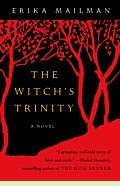|
The Witch's Trinityby Erika MailmanReviewed by Margaret Donsbach Güde is an old woman living with her son, his wife, and their two young children. In a winter following two years of parched weather and poor harvests, the village is suffering famine. The game in the nearby woods has been hunted out. Güde's daughter-in-law resents her presence, begrudging every drop of thin soup given to a woman too frail to work. A friar arrives from outside, well-fed and expensively dressed in voluminous robes, armed with a book titled the Malleus Maleficarum, "the Witch's Hammer." At Mass, he tells the villagers he is on a mission to find those responsible for the famine and punish them, so it may be lifted. "I was so happy.... The friar was like an altar carving come to life, one of the old saints surging forward with Christ's power in his gait and a Christian fire in his eyes." Then Güde's best friend, the village's herbal healer, is accused. The Witch's Trinity skirts the edge of surrealism at times as a famished Güde, suffering from the onset of dementia, has vivid and frightening, almost hallucinogenic dreams which she cannot always distinguish from reality. Ancient pagan rituals survive under the official superstitions of the Church, oddly reinforcing each other even as the Church condemns and forbids the remnants of paganism. Where the historical record documents persecutions founded on beliefs and accusations that seem like utter fantasy, Mailman's fiction is more believable than the factual material she bases it on, building from one all-too-credible scene to the next, showing how such beliefs and accusations might indeed develop. It is a grim and explicit tale, but one from which kindness and rational thought are never completely extinguished, leaving flickers of hope for the reader to catch at throughout. (2007, 274 pages, including an Author's Note discussing the historical background) More about The Witch's Trinity at Powell's Books
The Witch of Cologne by Tobsha Learner, (2003), about a Jewish midwife accused by the Inquisition in the seventeenth-century German city of Cologne. More info Calligraphy of the Witch by Alicia Gaspar de Alba (2007), about a Mexican servant girl caught up in the Salem witch hunt. More info The Heretic's Daughter by Kathleen Kent (2008), about a mother and daughter in Salem, Massachusetts, who discover a new respect for each other when the mother is charged with witchcraft. More info
Witch Hunting in Southwestern Germany 1562-1684: The Social and Intellectual Foundation by Erick H.C. Midelfort (1972) More info Witch Craze: Terror and Fantasy in Baroque Germany by Lyndal Roper (2004). More info Witchcraft in the Middle Ages by Jeffrey Burton Russell (1972). More info Witchcraft in Europe, 400-1700: A Documentary History by Alan Charles Kors (revised and expanded 2nd ed. 2000). More info
The Malleus Maleficarum, introduction and full text at www.MalleusMaleficarum.org Back to Novels of the Renaissance
|
